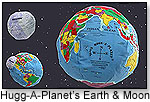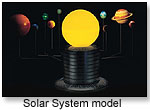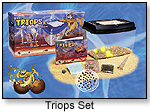
April 2, 2025


 What makes a good science and nature toy? Is it gauging the level of the science to the user? Is it making it fun (and if so, how)? How expert in science do you have to be to create a really interesting science toy? What makes a toy inspire the next Albert Einstein ... or the next Charles Darwin?
What makes a good science and nature toy? Is it gauging the level of the science to the user? Is it making it fun (and if so, how)? How expert in science do you have to be to create a really interesting science toy? What makes a toy inspire the next Albert Einstein ... or the next Charles Darwin?
“To inspire a great mind is to inspire great questions,” Robert Forenza of Hugg-A-Planet (Gift Guide) pointed out. It’s the very uniqueness of the questioning that differentiates science toys from any other play, be it television, toys or video games.
“A good science and nature toy will ‘hook’ a child’s attention,” related Nancy Balter, a product developer at Educational Insights Inc., “and then guide the child into making a discovery.”
 “The best science toys are those that spark questions, not answers,” iterated Forenza. That’s science and science toys in a nutshell.
“The best science toys are those that spark questions, not answers,” iterated Forenza. That’s science and science toys in a nutshell.
But they can’t be pedantic.
“We believe that first and foremost a toy has to be fun,” explained Joe Sykes, of Quercetti. “That has to be its most important trait. We never underestimate the intelligence of children either, and therefore we try to make the toy a little challenging, too.”
Balter seconded the idea of making toys challenging but age appropriate: “It’s definitely important to gauge the level of the science to the user. Studies have been done on the age(s) at which students can understand new concepts, and we take that into consideration. We also consider state and national science standards so we know at what age children are learning particular science facts and concepts in school.”
Sometimes, it’s the teachers themselves who help to shape the next great science kit.
“We always listen to our core customers, the teachers,” explained John White, director of marketing for Insect Lore. “We often try to facilitate habitats for things that the teachers are already raising.”
 Which leads to the question: How expert do you have to be to create a good science toy?
Which leads to the question: How expert do you have to be to create a good science toy?
Some companies are started by scientists, such as the neurophysiologist Eugene Hull, Ph.D, founder of Triops Inc. (Gift Guide), and Carlos White, the entomologist who began Insect Lore. The founding partner of SentoSphere was a “nose” for various perfume makers. But others come from less academic backgrounds. Quercetti’s background was as a World War II pilot. In the end, it’s the product that counts.
And the toy the next paradigm-shifting scientific genius is going to be inspired by …? Check below; it might be one of these:Slime Laboratory by TOYOPS INC.
This educational kit allows kids to make dripping, bouncing slimes and semisolids as they experiment with goo. They will learn about the fascinating science of polymers. 11/9/2005 (MSRP: $14.00)
Science of Special Effects by EDUCATIONAL INSIGHTS INC. This kit explores key concepts behind optical illusions and special effects as kids complete the 30 engaging experiments inside. Each experiment is fully illustrated in a step-by-step format, and then the science behind the effect is explained in kid-friendly language. The kit includes all components necessary, except for a few household items. 7/26/2006 (MSRP: $39.99; Age: 7 and Up)
This kit explores key concepts behind optical illusions and special effects as kids complete the 30 engaging experiments inside. Each experiment is fully illustrated in a step-by-step format, and then the science behind the effect is explained in kid-friendly language. The kit includes all components necessary, except for a few household items. 7/26/2006 (MSRP: $39.99; Age: 7 and Up)
Mars by HUGG-A-PLANET This is the most detailed globe of Mars available anywhere. Visit the Red Planet with more than 400 places labeled. It is proportional to classic Earth. The globe comes with a fact sheet on the planet Mars. 7/26/2006 (MSRP: $16.95; Age: 4 and Up)
This is the most detailed globe of Mars available anywhere. Visit the Red Planet with more than 400 places labeled. It is proportional to classic Earth. The globe comes with a fact sheet on the planet Mars. 7/26/2006 (MSRP: $16.95; Age: 4 and Up)
Georello Motor by QUERCETTI INTELLIGENT TOYS This motorized set is compatible with all the Georello line. It includes a new motor unit that has two controls: a large turning knob with three positions to determine the direction of rotation (forward, reverse, neutral) and a second large knob that works as a manual accelerator, determining the speed of rotation, from slow to very fast motion. This set includes six gears in three sizes and six interlocking plates. It also includes a booklet that shows how to integrate the motor unit into all the other Georello sets. 7/26/2006 (Age: 4 and Up)
This motorized set is compatible with all the Georello line. It includes a new motor unit that has two controls: a large turning knob with three positions to determine the direction of rotation (forward, reverse, neutral) and a second large knob that works as a manual accelerator, determining the speed of rotation, from slow to very fast motion. This set includes six gears in three sizes and six interlocking plates. It also includes a booklet that shows how to integrate the motor unit into all the other Georello sets. 7/26/2006 (Age: 4 and Up)
Beetle Barn by INSECT LORE Kids can follow the life cycle of the mealworm with this easy-to-raise, easy-to-do kit. It comes with a tri-chambered “Barn” habitat, a super magnifier for insect observation, detailed instructions with acres of insect information, and, most important of all, a certificate for 25 to 35 mealworm larvae. 7/26/2006 (MSRP: $19.99; Age: 8 and Up)
Kids can follow the life cycle of the mealworm with this easy-to-raise, easy-to-do kit. It comes with a tri-chambered “Barn” habitat, a super magnifier for insect observation, detailed instructions with acres of insect information, and, most important of all, a certificate for 25 to 35 mealworm larvae. 7/26/2006 (MSRP: $19.99; Age: 8 and Up)
Copyright © 2025 TDmonthly®, a division of TOYDIRECTORY.com®,
Inc.